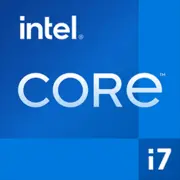Intel Core i7-1260P

Intel Core i7-1260P: A Versatile Processor for Mobile Tasks in 2025
Overview of Hybrid Architecture, Performance, and Use Cases
Architecture and Process Technology: Hybrid Power of Alder Lake
The Intel Core i7-1260P processor, released in 2022, remains relevant in 2025 thanks to its Alder Lake hybrid architecture. This is Intel's first mobile chip that combines performance (P-cores) and efficiency (E-cores) cores.
- 12 cores (4P + 8E) and 16 threads: P-cores (Golden Cove) handle heavy tasks with Hyper-Threading support (8 threads), while E-cores (Gracemont) manage background processes.
- Clock speeds: Base frequency of P-cores is 2.5 GHz, with a maximum turbo frequency of 4.7 GHz. E-cores operate at 1.8–3.4 GHz.
- Intel 7 (10nm Enhanced SuperFin): The manufacturing process provides a balance between performance and power consumption.
- Intel Iris Xe Graphics (96 EU): The integrated graphics supports 4K displays, AV1 encoding, and provides up to 60 FPS in light gaming.
Example: When rendering video in DaVinci Resolve, P-cores are utilized for computations while E-cores handle background processes of the browser and messaging apps.
Power Consumption and TDP: Dynamic Optimization
The nominal TDP of the processor is 28 W, but actual consumption varies from 20 W (in office tasks) to 64 W (in turbo mode).
- Intel Dynamic Tuning 2.0: Algorithms automatically adjust power according to load and temperature.
- Thermal Velocity Boost: When the temperature is below 70°C, the frequency of P-cores temporarily increases by 100–200 MHz.
- Idle Savings: In idle mode, E-cores drop the frequency to 800 MHz, and the iGPU is disabled.
Tip: In laptops with passive cooling (like the Dell XPS 13), the i7-1260P is limited to 25 W to reduce heating.
Performance: From Office to Gaming
Office Tasks
- Chrome with 20 tabs + Zoom + Excel: CPU load is 30–40%, temperature is 45–55°C.
- Running Virtual Machines (VMware): 16 threads allow for working with 2-3 light VMs simultaneously.
Multimedia
- Premiere Pro (H.264 4K): Rendering takes 8–10 minutes (compared to 15 minutes with the i7-1165G7).
- HandBrake (video conversion): All cores are engaged; the processor is 15% faster than the Ryzen 7 6800U.
Gaming
- CS:GO (1080p, low settings): 90–110 FPS.
- The Witcher 3 (720p, low): 35–40 FPS.
- Turbo Mode: In games lasting up to 10 minutes, the iGPU frequency stays at 1.3 GHz, then drops to 1.0 GHz due to heating.
Use Cases: Who Is the i7-1260P Suited For?
1. Mobile Professionals: Designers, programmers, analysts working in Photoshop, VS Code, Tableau.
2. Students: Multitasking (lectures in Zoom, typing, streaming).
3. Travelers: Light gaming and 4K video streaming on the go.
Example Laptop: Lenovo ThinkPad X1 Carbon (2025) — weight 1.1 kg, battery life up to 14 hours, price starting at $1499.
Battery Life: Balancing Power and Efficiency
With a battery capacity of 60 Wh:
- Office Tasks: 8–10 hours (brightness 150 nits, Wi-Fi on).
- Video Playback: 6–7 hours (4K on YouTube).
- Power-saving Technologies:
- Adaptix Dynamic Tuning: Reduces E-cores frequency when running on battery.
- Display Power Saving: Auto-adjusts screen brightness and refresh rate.
Life Hack: Disabling Turbo Boost in Windows settings increases battery life by 20–25%.
Comparison with Competitors
AMD Ryzen 7 7840U (Zen 4)
- Pros: Better multithreaded performance (+10%), support for LPDDR5X.
- Cons: iGPU Radeon 780M lags behind Iris Xe in Ray Tracing.
Apple M2 (MacBook Air)
- Pros: Battery life up to 18 hours, runs cool.
- Cons: Limited compatibility with Windows software.
Laptop Prices:
- Dell XPS 13 with i7-1260P — $1399.
- MacBook Air M2 — $1299.
Pros and Cons of the Processor
Strengths:
- Hybrid architecture for multitasking.
- Support for Thunderbolt 4 and Wi-Fi 6E.
- Good graphics for less demanding gaming.
Weaknesses:
- Heating in turbo mode (up to 95°C in thin laptops).
- Dependency on OS optimization (Windows 11 recommended).
Recommendations for Laptop Selection
1. Types of Devices:
- Ultrabooks: ASUS ZenBook 14X (price starting at $1299).
- Business Laptops: HP EliteBook 840 G9 (from $1599).
- Compact Workstations: MSI Prestige 14 (from $1699).
2. What to Look For:
- Cooling System: Two fans and heat pipes.
- Display: 100% sRGB and HDR400 for creative tasks.
- Memory: 16+ GB LPDDR5.
Final Conclusion
The Intel Core i7-1260P in 2025 is an optimal choice for those seeking a versatile laptop for work and leisure. It suits:
- Freelancers processing photos and videos.
- Students balancing study and entertainment.
- Travelers valuing battery life.
Key Advantages: The power of hybrid cores, decent graphics, and support for modern connectivity standards. If your budget is $1300–1700, this processor will serve as a reliable foundation for 3-4 years.
Basic
CPU Specifications
Memory Specifications
GPU Specifications
Miscellaneous
Benchmarks
Compared to Other CPU
Share in social media
Or Link To Us
<a href="https://cputronic.com/cpu/intel-core-i7-1260p" target="_blank">Intel Core i7-1260P</a>